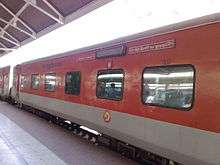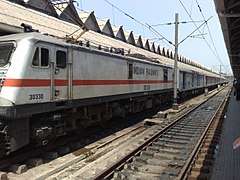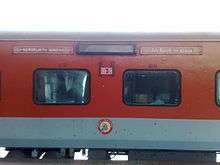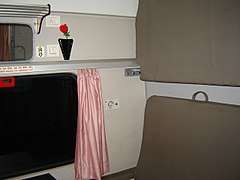Howrah Rajdhani Express
 Howrah Rajdhani Express signboard outside of the compartment | |||||
| Overview | |||||
|---|---|---|---|---|---|
| Service type | Rajdhani Express | ||||
| Status | Operating | ||||
| Locale | West Bengal, Jharkhand, Bihar, Uttar Pradesh & Delhi | ||||
| First service | 1 March 1969[1] | ||||
| Current operator(s) | Eastern Railways | ||||
| Route | |||||
| Start | Howrah Junction (HWH) | ||||
| Stops | 7 | ||||
| End | New Delhi (NDLS) | ||||
| Distance travelled |
1,451 km (902 mi) (via Gaya Junction) 1,430 km (890 mi) (via Patna Junction) | ||||
| Average journey time |
17 hrs 10 mins (for 12301) 16 hrs 55 mins (for 12302) 19hrs 55 mins (for 12305) 19 hrs 20 mins (for 12306) [2] [3] | ||||
| Service frequency |
6 days (via Gaya) Sunday (via Patna) | ||||
| Train number(s) |
12301/12302 (via Gaya) 12305/12306 (via Patna) | ||||
| On-board services | |||||
| Class(es) | AC 1st Class (1A), AC 2 Tier (2A), AC 3 Tier (3A) | ||||
| Seating arrangements | Yes | ||||
| Sleeping arrangements | Available | ||||
| Auto-rack arrangements | No | ||||
| Catering facilities | Available (included in the ticket fare)(IRCTC) | ||||
| Observation facilities | Large Windows | ||||
| Entertainment facilities | Onboard WiFi Service | ||||
| Baggage facilities | Available | ||||
| Technical | |||||
| Rolling stock | LHB Coaches | ||||
| Track gauge | 1,676 mm (5 ft 6 in) | ||||
| Operating speed |
| ||||
| |||||
Howrah Rajdhani is the most prestigious Rajdhani class train in India which connects New Delhi to Howrah, Kolkata. The Howrah Rajdhani was the first Rajdhani Express in India, thereby becoming the first fully air-conditioned train in the country. The train is one of the fastest in India with an average speed of 88 km/h (55 mph).[4] Howrah Rajdhani gets highest priority on Howrah–Delhi main line and Howrah-Delhi Grand Chord Line. It connects two big metropolis of India.
The Howrah Rajdhani Express began operations on 3rd March, 1969. The train departed from the New Delhi railway station to reach the Howrah Junction railway station in 17 hours 20 mins, covering a distance of 1,451 km (902 mi) .The express train reduced the travel time from Delhi to West Bengal from an earlier 24 hours to 17 hours. The Howrah Rajdhani is amongst few trains which are fully served by IRCTC, while others are Sealdah Duronto, Mumbai Rajdhani Express and Ahmedabad Rajdhani. Howrah Rajdhani is affectionally called the King by Railfans. Howrah Rajdhani is also the country's first WiFi enabled Rajdhani
History
The idea of introducing Rajdhani express as a set of superfast express trains met with consternation and criticism due to both political reasons and the fear of the proposed speed leap from the then maximum permissible speed of express trains of 100 km/h (62 mph) to 140 km/h (87 mph) for trial runs of the train. The planning team behind the idea of such express trains made proposals to the zonal railways whose territories the Rajdhani express would be crossing but was met with opposition. The team was however, able to materialise its plan. The civil aviation in India was back then at its inception which made it was necessary to introduce high speed railway connectivity between metropolitan cities to allow faster travel. The introduction of such fast passenger express trains in the country was an important step for the Indian Railways to take the railway network in India closer to the advanced and high speed railways around the world.
The Howrah Rajdhani express was introduced on 1st March 1969. It was flagged-off from New Delhi at 5:30 pm IST for Howrah and arrived at the Howrah junction station at 10:50 am IST next morning. The New Delhi bound Rajdhani express departed from Howrah at 5:00 pm IST on 3rd March, 1969 and arrived at New Delhi at 10:20 am IST next morning. It was initially a bi-weekly train with coach composition as below:
Brake/Luggage/Generator, AC I, AC Pantry cum Lounge, AC Chair, AC Chair, AC Chair, AC Chair, Brake/Luggage/Generator
It was hauled by a single WDM-4 locomotive. It left Howrah on Wednesdays and Saturdays and left New Delhi on Mondays and Fridays. The booked speed for the train was 115 km/h (71 mph) while maximum permissible speed limit was 120 km/h (75 mph). At that time it was the only train allowed to run at such a speed. It covered a distance of 1,451 km (902 mi) in 17 hours 00 minutes. The ticket issued for the journey cost ₹280 (equivalent to ₹10,000 or US$140 in 2017) for AC First and ₹90 (equivalent to ₹3,300 or US$46 in 2017) for AC Chair Car. The train used to run via Grand Chord (Sitarampur - Mughalsarai via Gaya). It used to have no intermediate passenger stop, however it had technical halt at Gomoh, Mughalsarai and Kanpur Central for refilling of the overhead water tank and to replenish the on-board catering stores. Passengers could sit in the lounge next to pantry car and read magazines and play cards. Such recreational accessories were supplied free of cost in the lounge.
The AC equipment of each coach was of 'Stone Career Automatic System' which allowed electric heating to be automatically switched on during cold weather. The AC First coach used to have three cabins with each cabin containing four berths and three coupes and each coupe containing two berths. Each cabin and coupe had privacy curtains in addition to lockable doors, extra-wide windows, window curtain, carpets, sunk-in upper berth, night lamps and switch to coax a bell to summon the attendant as and when required.
The AC Chair Car coaches used to have accommodations for 71 passengers. Both AC First as well as AC Chair Car Coaches were provided with foot-operated wash basins. Many of these features do not resemble the standard features of modern Indian Railways Rolling Stocks.
Power was generated at the rate of 440V AC and was fed to each coach through interconnected coach couplers. There was also a 24V emergency lighting arrangement in each coach with the required power to be supplied from the storage batteries underneath in the event of a power failure.
In April 1971, the Northern Railway (NR) introduced a quota of 10 seats in the AC Chair Car of the train for Howrah-Kanpur passengers and 10 seats for Howrah-New Delhi passengers. Thus Kanpur also became a passenger stop for the Howrah Rajdhani Express. Eventually Mughalsarai was also turned into a passenger cum technical stop. Dhanbad was newly introduced as a passenger stop. The stoppage from Gomoh was removed.
In 1 November 1971, the maximum speed limit of Howrah Rajdhani Express was increased from 120 km/h (75 mph) to 130 km/h (81 mph). This also reduced the running time for the Up train by 25 minutes and Down train by 30 minutes.
- The departure and arrival time of the Up train were rescheduled as : HWH: 4:55 pm, NDLS: 10:00 am
- The departure and arrival time of the Down train were rescheduled as : NDLS: 4:55 pm, HWH: 10:00 am
Till May, 1972, Howrah Rajdhani used to be the only Rajdhani express in India. On 17 May 1972, New Delhi-Bombay Central Rajdhani express was introduced. Thus, for another two decades(1972-1992), Indian Railways would have two Rajdhani expresses dominating in the realm high speed long distance connectivity.
By August 1972, the frequency of Howrah Rajdhani had been increased and the train was making substantial profit to the range to ₹20,000 (equivalent to ₹640,000 or US$8,900 in 2017) to ₹30,000 (equivalent to ₹960,000 or US$13,000 in 2017) per trip.
Even though, Howrah-New Delhi trunk route via Grand-Chord had been fully electrified by 1976, Howrah Rajdhani used to be hauled by a WDM-4. These WDM-4s had superior bogie design which meant they could accelerate faster and brake at higher speeds. They were also rated at 130 km/h (81 mph), a little above other WDM-4 locomotives with a maximum permissible speed limit of 120 km/h (75 mph). Mughalsarai had workshop and maintenance facilities for these special WDM-4 locomotives which justified the 12 minutes halt of Howrah Rajdhani express at Mughalsarai. Sometimes the locomotive would also change here.
Indian Railways felt the necessity of introducing a new electric locomotive for Howrah Rajdhani express to promote higher speed economically, Howrah-New Delhi route having already been fully electrified. Thus, CLW received the commission of building the first WAP-1 locomotive in 1980[5] with a matching livery. But it was not until 1983 that the train would be hauled by WAP-1. The WAP-1 AC electric locomotive could haul 18 coaches of Rajdhani at a speed of 125 km/h (78 mph). By that time, the coaches of Howrah Rajdhani had been augmented with new AC 2 tier coaches being introduced. Usually a single WAP-1 loco from Ghaziabad shed would haul the train through late 1980s though occasionally twin WAP-1 could also be spotted. Later, WAP-2 locomotives were also used to pull the train sometimes. In 1986, the train got air-brakes. In the event of failure of the regular WAP-1 locomotive, a WAG-7 was used to haul the train as WAG-7 was at that time one of the rarer locomotives to be equipped with air-brakes. It was also the first train to be hauled by WAP-5 locomotive. In the early days of the WAP-5 locos, the train was hauled by WAP-1 locos on Tuesdays and Fridays (when it went through Patna) and dual WDM-2 locos hauled it from Mughalsarai onwards.
In 1992, RDSO/ICF develop high-capacity (250kVA) power cars for Howrah Rajdhani.
In 1993, AC-3 Tier coaches were introduced in Howrah Rajdhani via Main Line(Patna). Thus, Howrah Rajdhani would boast a coach combination of AC Chair Cars, AC 3-Tiers, AC 2-Tiers and AC First. It is regularly hauled by a WAP 7 locomotive of Howrah and Ghaziabad . Sometimes as an off link it is hauled by WAP 4 locomotive of Howrah. Based the popularity of the Howrah Rajdhani, the Sealdah Rajdhani Express was made functional. Sealdah is another railway station in Kolkata.




Coach Composition

The trains have high priority on the Indian railway network and are fully air-conditioned. It is hauled by an HOG WAP 7 of Howrah shed and Its color is red-grey.
- The trains comprises 2 First AC (1A), 5 AC 2-Tiers (2A), up to 10 AC 3-Tiers (3A) ( both of which may be increased according to demand), 1 AC Hot Buffet Car (i.e. Pantry Car) & 2 Luggage/Parcel cum Generator cum Brake van one of which is provided with the Guards' cabin.
- Legends
| LRM/GD/EOG/SLR | B- | A- | H- | PC |
|---|---|---|---|---|
| Generator cum luggage van | Third AC (3A) | Second AC (2A) | First AC (1A) | Pantry Hot buffet car |
- Rake composition of 12301 (via Gaya) & 12305 (via Patna)
| Loco | 1 | 2 | 3 | 4 | 5 | 6 | 7 | 8 | 9 | 10 | 11 | 12 | 13 | 14 | 15 | 16 | 17 | 18 | 19 | 20 |
|---|---|---|---|---|---|---|---|---|---|---|---|---|---|---|---|---|---|---|---|---|
| LRM1 | B-1 | B-2 | B-3 | B-4 | B-5 | B-6 | B-7 | B-8 | B-9 | B-10 | PC | H-1 | H-2 | A-1 | A-2 | A-3 | A-4 | A-5 | LRM2 |
- 12302 (via Gaya) & 12306 (via Patna)- Reverse rake composition of 12301/12305
Destinations
The train is an important link between Kolkata and New Delhi. It runs near some of the most holy sites in India, including Allahabad, Gaya, and Parasnath. It also connects the financial capital of Uttar Pradesh, Kanpur, to Delhi and Kolkata.Train also halts at Asansol west bengal and Dhanbad(Jharkhand).
See also
References
- ↑ "Railway Budget speech 1970-71" (PDF). www.indianrailways.gov.in. Government of India, Ministry of Railways. 23 February 1970.
- ↑ "HWH - NDLS 12301".
- ↑ HWH - NDLS 12305
- ↑ "Fastest trains in India". India.com.
- ↑ "Railway Budget speech 1981-82" (PDF). www.indianrailways.gov.in. Government of India, Ministry of Railways. 19 February 1981.
External links
_Rajdhani_Express_(via_Gaya)_Route_map.png)